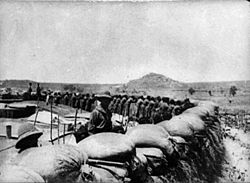Second Battle of Garua facts for kids
Quick facts for kids Second Battle of Garua |
|||||||
|---|---|---|---|---|---|---|---|
| Part of the Kamerun campaign in World War I | |||||||
 German trenches at Garua during the Kamerun Campaign |
|||||||
|
|||||||
| Belligerents | |||||||
|
|
||||||
| Commanders and leaders | |||||||
| Units involved | |||||||
| West African Frontier Force | |||||||
| Strength | |||||||
| ~500 | |||||||
| Casualties and losses | |||||||
| None | 249 captured others killed or deserted |
||||||
The Second Battle of Garua was an important fight during World War I. It happened in Garua, a place in what was then German Kamerun. This battle took place from May 31 to June 10, 1915. It was a clash between soldiers from France and the British Empire against German forces. The battle ended with a win for the French and British side.
Why This Battle Happened
After a first attempt by the British to take Garua in August 1914 didn't work, the German soldiers there became very confident. Their leader, Captain von Crailsheim, even led attacks into British Nigeria. One of these attacks, the Battle of Gurin in April 1915, was quite big.
This attack surprised Colonel Cunliffe, who was the new Allied commander in the area. He decided it was time to try and capture the German forts at Garua again. British and French forces joined together for this new attempt. They even brought in large naval guns from ships to help with the attack.
The German forts at Garua had been made much stronger since the first battle. Captain von Crailsheim had used many local workers to build up the defenses. They added barbed wire, earth walls, and dugouts. He also brought in German sailors to help defend the forts. The forts had many machine guns and field guns. They also stored lots of food and supplies, ready for a long fight.
The Siege and Fight
French and British soldiers surrounded the forts at Garua on May 31, 1915. They started to dig trenches closer to the German defenses. Colonel Cunliffe figured out that the northern side of the forts was the weakest. So, he focused his attacks there.
Every night, the Allied soldiers would dig tunnels and trenches even closer to the German forts. This slowly weakened the German defenses. The Germans inside the forts fired back, but their shots weren't very effective.
The big naval guns brought by the Allies caused a lot of damage to the German forts. The constant shelling also made the German soldiers lose their confidence. One shell even killed 20 German soldiers at once.
By June 9, many of the local soldiers fighting for the Germans started to refuse orders. Some tried to run away but were forced back by gunfire. Others tried to escape by riding horses towards the Benue River. The river was flooded, and many of them drowned trying to cross. About 70 bodies were found later. Only a few managed to escape, but they were chased by British and French soldiers.
The End of the Battle
After losing many soldiers and facing heavy shelling, the German forts raised white flags on June 10. This meant they wanted to surrender. Captain von Crailsheim asked for special surrender terms, but the Allied commander said no.
At 6:30 p.m., the German commander surrendered completely. On June 11, Allied troops entered the forts. Only 37 German soldiers and 212 local soldiers were left. The rest had either run away or been killed. The Allied forces did not lose any soldiers in this battle.
What Happened Next
With the German surrender, the remaining soldiers were taken as prisoners. The Allies also captured all the weapons, ammunition, and supplies that the Germans had stored.
Taking Garua was a big win. It left another German stronghold, Mora, all alone in northern Kamerun. Mora later surrendered at the end of the campaign. The success at Garua allowed Colonel Cunliffe to move his forces further south into Kamerun. He led his troops to the town of Ngaundere, which they captured after some fighting.


